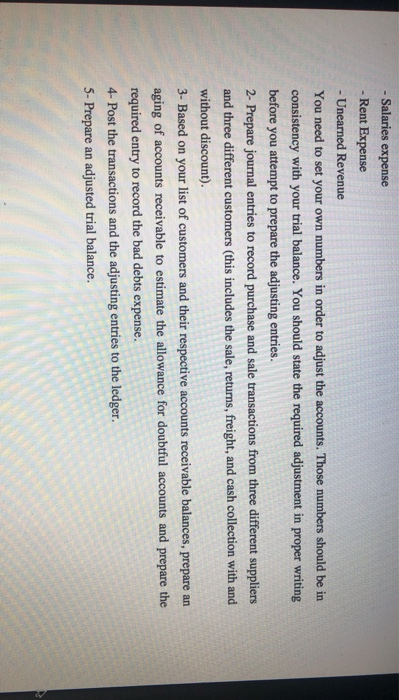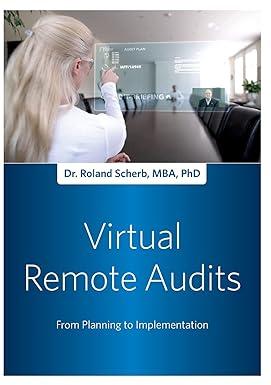Automatic Zoom You have a business (a merchandising company) that you will need to apply the main financial accounting concepts to it. You will create your own company name, and prepare the following requirements: Start with an initial trial balance (you can create your own or choose one from the exercises in the book), make sure the trial balance includes different assets, liabilities, equity, revenues and expenses that will be used for the requirements below. Building on this trial balance, attempt to prepare the following: 1- Prepare the adjusting entries for the following accounts: - supplies (Supplies Expense) - Accumulated Depreciation Equipment - Allowance for Doubtful Accounts (Bad debt expense) - Notes receivable Interest Receivable) - Notes payables (Interest Payable) - Salaries expense - Rent Expense - Unearned Revenue You need to set your own numbers in order to adjust the accounts. Those numbers should be in consistency with your trial balance. You should state the required adjustment in proper writing before you attempt to prepare the adjusting entries. Macron - Salaries expense - Rent Expense - Unearned Revenue You need to set your own numbers in order to adjust the accounts. Those numbers should be in consistency with your trial balance. You should state the required adjustment in proper writing before you attempt to prepare the adjusting entries. 2- Prepare journal entries to record purchase and sale transactions from three different suppliers and three different customers (this includes the sale, returns, freight, and cash collection with and without discount) 3- Based on your list of customers and their respective accounts receivable balances, prepare an aging of accounts receivable to estimate the allowance for doubtful accounts and prepare the required entry to record the bad debts expense. 4- Post the transactions and the adjusting entries to the ledger. 5- Prepare an adjusted trial balance. 6- Prepare financial statements: Income Statement, Retained Earnings Statement, and Statement of Financial Position. 7- Journalize and post the closing entries. 8- Prepare a post-closing trial balance. 9- Prepare a multiple step income statement based on your trial balance and the transactions prepared above. Note, you need to set your own numbers, build on any example from the book, or choose a real- life example. You can estimate numbers as you need to. Those numbers should be consistent with your trial balance. You should write enough details before each transaction and state any assumptions you make in a clear form. Automatic Zoom You have a business (a merchandising company) that you will need to apply the main financial accounting concepts to it. You will create your own company name, and prepare the following requirements: Start with an initial trial balance (you can create your own or choose one from the exercises in the book), make sure the trial balance includes different assets, liabilities, equity, revenues and expenses that will be used for the requirements below. Building on this trial balance, attempt to prepare the following: 1- Prepare the adjusting entries for the following accounts: - supplies (Supplies Expense) - Accumulated Depreciation Equipment - Allowance for Doubtful Accounts (Bad debt expense) - Notes receivable Interest Receivable) - Notes payables (Interest Payable) - Salaries expense - Rent Expense - Unearned Revenue You need to set your own numbers in order to adjust the accounts. Those numbers should be in consistency with your trial balance. You should state the required adjustment in proper writing before you attempt to prepare the adjusting entries. Macron - Salaries expense - Rent Expense - Unearned Revenue You need to set your own numbers in order to adjust the accounts. Those numbers should be in consistency with your trial balance. You should state the required adjustment in proper writing before you attempt to prepare the adjusting entries. 2- Prepare journal entries to record purchase and sale transactions from three different suppliers and three different customers (this includes the sale, returns, freight, and cash collection with and without discount) 3- Based on your list of customers and their respective accounts receivable balances, prepare an aging of accounts receivable to estimate the allowance for doubtful accounts and prepare the required entry to record the bad debts expense. 4- Post the transactions and the adjusting entries to the ledger. 5- Prepare an adjusted trial balance. 6- Prepare financial statements: Income Statement, Retained Earnings Statement, and Statement of Financial Position. 7- Journalize and post the closing entries. 8- Prepare a post-closing trial balance. 9- Prepare a multiple step income statement based on your trial balance and the transactions prepared above. Note, you need to set your own numbers, build on any example from the book, or choose a real- life example. You can estimate numbers as you need to. Those numbers should be consistent with your trial balance. You should write enough details before each transaction and state any assumptions you make in a clear form









